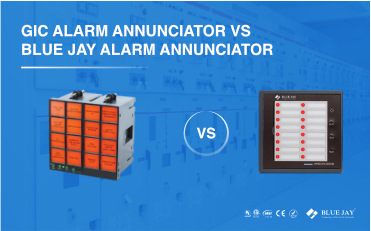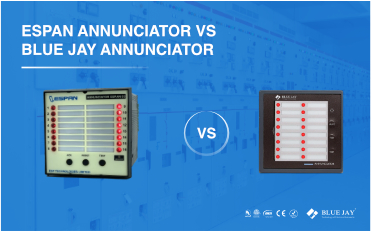
GIC Alarm Annunciator VS Blue Jay Alarm Annunciator
In modern industry and automation, alarm annunciators are essential

In critical applications such as switchgear, GIS (gas-insulated switchgear), and local control panels for power transformers, alarm annunciators are central to ensuring safety and operational integrity. Both EPSAN and Blue Jay are prominent manufacturers offering reliable solutions in this field. While their fault annunciators share many similarities, a closer look at their key differences will help professionals make a more informed and optimal selection.
The EPSAN annunciator and Blue Jay annunciator share many common design concepts and features, making them interchangeable in certain applications.
Wide Application: Both annunciator systems are designed for industrial environments such as switchgear compartments, GIS local control panels, and transformer control cabinets, and can withstand demanding operating conditions.
Compact Size: Both EPSAN annunciator and Blue Jay annunciator utilize the industry-standard 96 x 96 mm panel size, making them easy to integrate into various control cabinets and effectively saving valuable cabinet space.
Number of Alarm Annunciator Channels: Both brands offer models with up to 16 channels, meeting the needs of most small and medium-sized control panels. While Blue Jay provides options from 4 to 16 channels, EPSAN offers models from 8 to 20 channels, including a common 16-channel option.
Basic Operation: Both EPSAN annunciator and Blue Jay annunciator feature built-in physical buttons for Acknowledge/Mute, Reset, and Test, providing a convenient interface for on-site operators.
User-Friendly Labeling: Both EPSAN annunciator and Blue Jay annunciator utilize paper labels that slide into a transparent slot on the front panel, allowing users to define alarm descriptions based on actual signals, making replacement and maintenance easier.
Power Supply voltage
The EPSAN annunciator offers multiple fixed voltage options, including 24V, 48V, 110V, 125V, 220V, and 230V DC. This design allows for a precise match with specific power systems but requires customers to select the exact voltage model during the ordering process.
In contrast, the Blue Jay alarm annunciator features a wide-range voltage input (85-265V AC/DC) with an optional 24VDC model. This approach simplifies both selection and inventory, as a single model can accommodate a variety of voltage environments worldwide, ultimately reducing procurement costs.
Alarm sequence
The EPSAN alarm annunciator offers a more specialized option. Each input channel’s alarm sequence can be configured as either Auto Reset, Manual Reset, or Indicator. This flexibility allows the EPSAN to meet more complex operating requirements, such as configuring certain signals to be indication-only without triggering audible or visual alarms.
The Blue Jay alarm annunciator offers only two basic alarm sequences: Auto Reset and Manual Reset. Its relatively simplified alarm logic is designed to meet general, basic alarm needs.
Alarm sound type
The EPSAN annunciator offers two selectable alarm sound: buzzer and bell. This allows users to select different sound types based on the urgency of the alarm or the surrounding environment.
The Blue Jay alarm annunciator only features a buzzer as its sole alarm sound source.
Communication interface
The choice of communication interface directly determines whether the alarm can be integrated into a more advanced monitoring network.
The EPSAN alarm annunciator uses an RS232 communication port. This interface is typically used for short-distance, point-to-point data transmission, for example, uploading alarm information to a local industrial computer or PC.
The Blue Jay alarm annunciator uses an RS485 interface, which is more suitable for industrial applications. RS485 supports longer communication distances (up to 1.2 kilometers) and the networking of multiple devices (multi-drop communication), making it easier to integrate into large-scale SCADA or DCS systems.
The final choice between the EPSAN and Blue Jay annunciators depends on your project’s priorities.
EPSAN is the ideal solution for specialized applications demanding precision, such as when advanced alarm sequences or specific fixed voltage inputs are required.
In contrast, the Blue Jay annunciator is the optimal choice for projects prioritizing simplicity and cost-effectiveness, offering a highly practical, all-in-one design with a wide-range power supply and standard RS485 port for easy integration.

In modern industry and automation, alarm annunciators are essential

Both the EES Annunciator and Blue Jay Fault Annunciator





